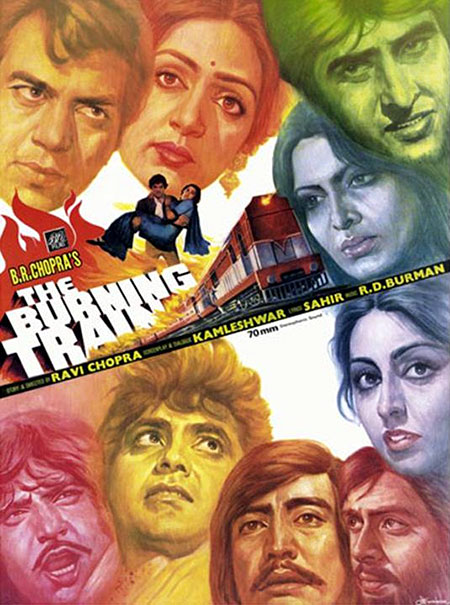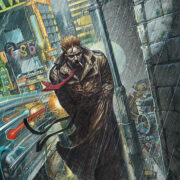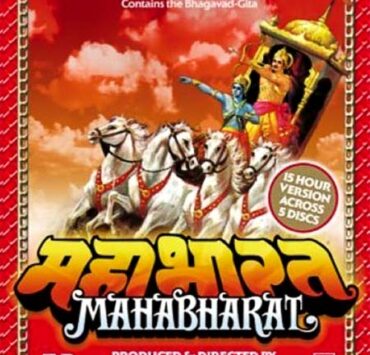The first time I watched The Burning Train, I didn’t sleep all night. My mum tells me that I was so taken aback by the film, I kept asking her questions about how a train operates and why it was so difficult to stop that train.
At that point, maybe I was just a curious kid looking for answers, but over the years, what has kept me coming back to this movie has been the thrill associated with every minute of the film; the twists that never cease to surprise; the diverse characters; and the simplicity with which a disaster as grave as a train on fire is shown. The plot of the movie was straightforward: it revolved around a train—India’s fastest—between Mumbai and Delhi catching fire on its maiden journey. The movie had all the ingredients of a masala entertainer; it even had two of the best looking heroes of that era—Dharmendra and Vinod Khanna—and yet something about the movie did not connect with the audience. Perhaps cinegoers at the time were just not used to the disaster genre when it came to Bollywood.

The Burning Train (1980) film poster.
The Burning Train is not a film you would easily associate with Ravi Chopra, best known to the present generation as late filmmaker B. R. Chopra’s son and the maker of family dramas such as Baghban and Baabul. As admitted by him, the inspiration for the film came from The Towering Inferno (1974), a film whose plot revolves around a building catching fire. Chopra decided to replace the building with a running train. This he did because he was keen on paying tribute (which he does in the end credits) to the Railways, which during the 1980s provided the highest employment in the country, and the Rajdhani Express, which was widely admired in that era.
To make the movie saleable, Chopra roped in a bunch of popular actors: Vinod Khanna, Dharmendra, Jeetendra, Neetu Singh, Parveen Babi, Hema Malini, Vinod Mehra, and Danny Denzongpa. After the regular dose of action, romance, drama, and tragedy in the first 45 minutes, the movie takes off when Khanna flags off his creation—the Super Express, a train that runs between Delhi and Bombay in a record time of 14 hours. However, Khanna’s nemesis Denzongpa, who loses out on the train project decides to take revenge by planting a bomb in the train and rendering the brakes useless.
On board are Khanna’s best friend Dharmendra, his ex-flame Hema Malini, Khanna’s son, and Vinod Mehra’s pregnant wife. To add a flavour of India to the film there are also a set of standard stock characters. A petty thief (Jeetendra), a runaway bride (Neetu Singh), a school teacher (Simi Garewal) with an army of school kids, a smuggler (Ranjeet), a doctor (Navin Nischol), a courtesan (Asha Sachdev), an undercover cop (Sujit Kumar), a pompous army man (Asrani), a Hindu pandit, a Muslim fellow, a Sardarji, a Parsi, a Marwari, a Christian, and several other characters. While the brakes have failed and the engine drivers are dead, the passengers continue to make merry by singing songs and cracking jokes. Things get worse when the fire spreads rapidly and the heroes have to now move into action. Inside the train Dharmendra and Jeetendra take guard, while outside Khanna and Mehra are trying their best to get things out of the train’s way for its safe arrival. Several subplots keep the story alive within the train, even while the main plot of saving the passengers is juiced out really well.
The film has a happy ending with the heroes of the film managing to get their act together in saving the passengers while the villains meet their end. However, what makes the movie special is its innovative use of the train. For years, the train has been a ubiquitous, yet majorly side-lined prop in a number of Bollywood movies: Bunty aur Babli, Jab We Met, Sholay, Dilwale Dulhaniya Le Jayenge, Kuch Kuch Hota Hai. Trains have played a pivotal role in all of these films, but never before has the plot of a film revolved around a train.
One of the slickest action movies of its time, The Burning Train has some of the best complex action sequences, car chase scenes, miniatures, and aerial shots which still manage to hold your attention today. The ensemble cast adds to the enigma of the film, and the song and dance gives it the much required Bollywood twist. It is hard to say why this movie was a commercial disaster despite a tight screenplay and good performances. Maybe it was ahead of its time, or maybe the emergence of larger-than-life villains with strange names, such as Lion, Shakaal, and Dr. Dang did not let this band of heroes shine.









Excellent read!